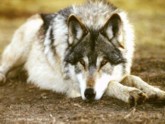 Wolves WolvesWolf History, Conservation, Ecology and Behavior
[www.wolfology.com]
|
 photo by Monty Sloan
|
|
Wolf Wars in the French Alps
Jason Manning
|
In the early 1990s, after an absence of over fifty years, wolves reappeared in the French Alps. In 1992, sightings in Mercantour National Park were confirmed. Led by the French wolf advocacy organization Groupe Loup, conservationists were encouraged by the recolonization and were optimistic about the future of the species. Natural prey such as red and roe deer had increased in numbers, while the rural French population had been in decline for decades. But if the conservationists though this would diminish the chances of wolf-human conflict in France they were sorely mistaken.
Currently there are between thirty and fifty wolves in the Alpine region -- an area where sheep in the tens of thousands are pastured for five months out of the year. Shepherds claim that wolves have killed at least 5,000 sheep in the past few years. Their protests resulted in a recent proclamation by the French national assembly that the return of the wolf to France was "incompatible with the maintaining of French pastoralism." Anti-wolf forces called for the establishment of wolf-exclusion zones as well as wolf culls. Environmentalists challenged the claim that wolves were solely to blame for the livestock losses, shifting much of the responsibility to a large contingent of feral dogs that populate the area. They argued it was unlikely that such a small population of wolves could account for so many dead sheep, especially considering the presence of a more than adequate natural prey base. But the French shepherds would not be swayed from their determination to force the government to choose between them or the wolves. The war was on.
The government adopted certain measures to appease the livestock owners. They created a plan that would compensate shepherds for confirmed wolf kills of livestock. They encouraged the use of guard dogs such as the Great Pyrenees. These dogs, raised from puppyhood with sheep, are fiercely protective of the flocks, and have proven to be effective deterrents to wolf depredation. Electric fencing has been donated to create "harborages" where flocks can be sheltered for the night. Aversion devices such as noisemakers have also been used. By and large, though, these measures failed to placate the shepherds. Some insisted on the complete extermination of wolves, while others argued that wolves should be restricted to the two Alpine national parks, Mercantour and Queyras.
A similar conflict has arisen in Spain, where a healthy population of about 2,000 wolves has caused an escalation in livestock losses. And recently wolves have returned to the French Pyrenees. DNA analysis of hair samples in 1999 indicated the presence of wolves in the eastern portion of that mountain range. This was not news to shepherds in the Pyrenees, who had reported increased predation on flocks grazing near the Nohedes Nature Reserve for several years previous to the finding. Wolves had been absent from the Pyrenees since the 1920s -- and most shepherds there wish they still were.
Clearly, wolves are making a comeback in some of the more remote regions of Europe. But their return has sparked a great deal of controversy, and forced authorities as well as interest groups on both sides to confront the challenge of dealing with wolf-human conflict in a way that is fair to all concerned. The challenge of the 1990s was to restore the wolf; the challenge of the coming decade is to find an acceptable way for wolves and humans to coexist.
|
Copyright 2002 Jason Manning All Rights Reserved
Feel free to duplicate for educational purposes.
|